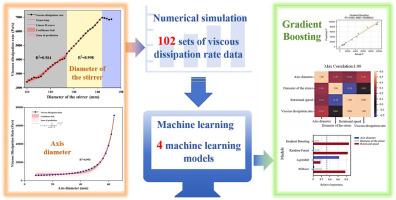解析多参数耦合动力学,建立基于机器学习的针式搅拌磨粘滞耗散率预测模型
IF 4.3
2区 材料科学
Q2 ENGINEERING, CHEMICAL
引用次数: 0
摘要
杆销搅拌磨是微米级粉体生产的关键设备,但对其多参数耦合下的磨矿机理的定量认识还不够。本文建立了基于计算流体力学的耦合流场模型,研究了搅拌器直径、轴径和转速对粘性耗散的影响。结果表明,这些参数与粘性耗散率呈正相关,并遵循幂律关系。其中,搅拌器直径呈两级线性增长,轴直径呈高斯型非线性增长。数值模拟结合机器学习进行灵敏度分析,转速影响最大,轴径次之,搅拌器直径次之。梯度增强模型的预测精度最高。研究结果为高性能搅拌磨的工程设计提供了定量依据。本文章由计算机程序翻译,如有差异,请以英文原文为准。

Unraveling multi-parameter coupling dynamics and building a machine learning-based predictive model for viscous dissipation rate in pin-type stirred mills
The rod and pin stirred mill is a key device for micron-sized powder production, yet the quantitative understanding of its grinding mechanism under multi-parameter coupling remains insufficient. This study develops a coupled flow field model based on computational fluid dynamic to investigate how agitator diameter, shaft diameter, and rotational speed influence viscous dissipation. Results reveal a positive correlation between these parameters and viscous dissipation rate, following a power-law relationship. Specifically, the agitator diameter shows a two-stage linear effect, while the shaft diameter exhibits Gaussian-type nonlinear growth. Numerical simulation combined with machine learning enables sensitivity analysis, indicating that rotational speed has the most significant impact, followed by shaft diameter and agitator diameter. The Gradient Boosting model demonstrates the highest prediction accuracy. These findings provide a quantitative basis for the engineering design of high-performance stirred mills.
求助全文
通过发布文献求助,成功后即可免费获取论文全文。
去求助
来源期刊

Particuology
工程技术-材料科学:综合
CiteScore
6.70
自引率
2.90%
发文量
1730
审稿时长
32 days
期刊介绍:
The word ‘particuology’ was coined to parallel the discipline for the science and technology of particles.
Particuology is an interdisciplinary journal that publishes frontier research articles and critical reviews on the discovery, formulation and engineering of particulate materials, processes and systems. It especially welcomes contributions utilising advanced theoretical, modelling and measurement methods to enable the discovery and creation of new particulate materials, and the manufacturing of functional particulate-based products, such as sensors.
Papers are handled by Thematic Editors who oversee contributions from specific subject fields. These fields are classified into: Particle Synthesis and Modification; Particle Characterization and Measurement; Granular Systems and Bulk Solids Technology; Fluidization and Particle-Fluid Systems; Aerosols; and Applications of Particle Technology.
Key topics concerning the creation and processing of particulates include:
-Modelling and simulation of particle formation, collective behaviour of particles and systems for particle production over a broad spectrum of length scales
-Mining of experimental data for particle synthesis and surface properties to facilitate the creation of new materials and processes
-Particle design and preparation including controlled response and sensing functionalities in formation, delivery systems and biological systems, etc.
-Experimental and computational methods for visualization and analysis of particulate system.
These topics are broadly relevant to the production of materials, pharmaceuticals and food, and to the conversion of energy resources to fuels and protection of the environment.
 求助内容:
求助内容: 应助结果提醒方式:
应助结果提醒方式:


